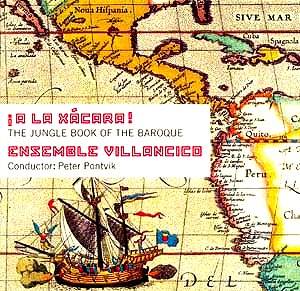
Crotchet
AmazonUK
AmazonUS |
ĦA LA XÁCARA!
The Jungle Book of the Baroque Les coflades de la estleya Hanacpachap cussisuinim Tleycantimo choquiliya Serenissima una noche Vachonloj ibankinal Las estreyas se rien St. Maria in Ilhuicac Tarantela por primer tono Al dichoso nace de mi niño Xicochi Instrumental piece Deus in aduutorium meum intende Xacara por primer tono Turulu neglo Gloria Patri A la xacara xacarilla Hijos d'Eva, tributarios Salga el torillo Si el amor se quedare dormido Oy es dia de placer Rec: January 2000, Petrus Church, Stockholm, Sweden. |
When the Conquistadors went to South America, they brought more with them than just weapons and disease. They also brought music, the vibrant music of the Iberian baroque. "They found that music could help them quickly convince the Indians to join in Christian daily life and eventually join the faith." But this music was soon adopted and converted by the indigenous population, for whom music had an important role in rituals and ceremonies. Before long, Indians were composing music combining their own background and the baroque brought by the conquerors, to create a unique musical idiom.
This disc features a selection of works written by Latin American composers between the 16th and 17th centuries. While a great deal of this music sounds distinctly Spanish, some of it combines indigenous forms and styles into an original form of baroque music.
Vachonloj ibankinal is a very Spanish-sounding piece, with a guitar strumming away behind a recorder, as a tambourine taps out the rhythm. Then a voice comes in, singing in a Maya dialect, almost a capella, and is joined by a chorus. This is energetic, festive music, with rhythm and a catchy melody - foot-tapping music, that combines old polyphonic forms with aggressive rhythms.
Polyphony can be heard in Las estreyas se rien, a piece for double chorus, that begins like many sacred works of the renaissance. It then takes off in a sort of contest between the two choruses, as they sing about a knights' tournament and the newly born baby Jesus.
The unnamed work (called Instrumental piece) is a mellow instrumental piece for gamba, guitar and percussion, which recalls some of the gamba sonatas of the 16th century. Its tone is lovely, and the underlying thump-thump of the percussion gives it a sound similar to many renaissance pieces.
This percussive nature permeates a great deal of this music. More than any European baroque music, here percussion instruments are often present, highlighting the rhythms of the music. A la xacara xacarilla is a piece for several voices and percussion, that recalls some of the troubadours' songs in its lively, dance-like sound.
This is a very interesting recording, presenting some little-known music from forgotten or unknown composers. The overall tone is festive and energetic, and is worth discovering for anyone who is interested in hearing some of the first results of "world music".
Kirk McElhearn